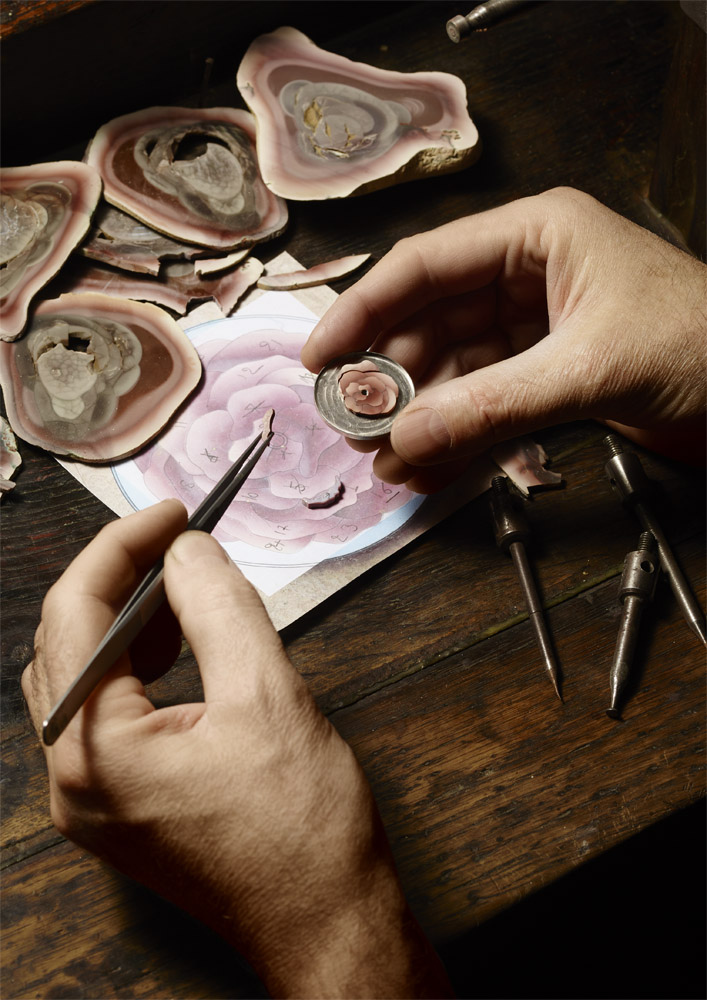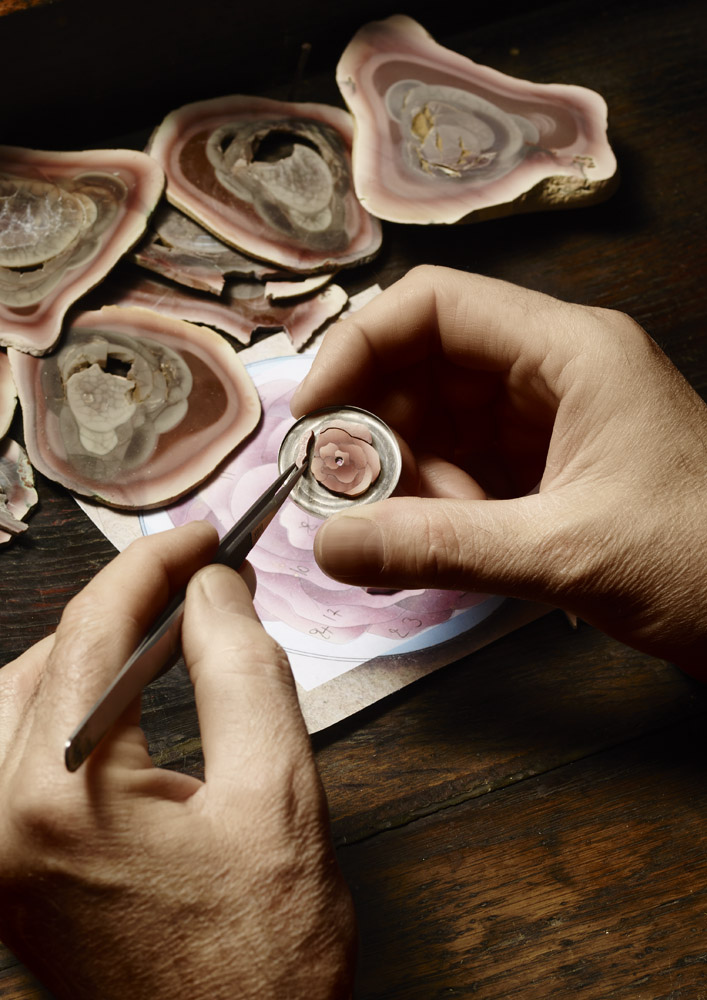
SIHH 2015: Piaget celebrates the queen of flowers through its Art & Excellence collection dedicated to artistic crafts
SIHH 2015: Piaget celebrates the queen of flowers through its Art & Excellence collection dedicated to artistic crafts
Since 1874, at its Manufacture in La Côte-aux-Fées, Piaget has been cultivating a tradition of excellence that extends through all watchmaking skills. The rarest movements, the most precious, as well as the thinnest, have been created by its watchmakers.
In 2015, the company combines this watchmaking art with that of exceptional artisans, around one of the Maison’s strongest emblems: the Rose, thus creating a series of unique watches entirely in line with the grand creative tradition of the Manufacture.
The rose is one of Piaget’s icons. “It is the most universal of all flowers” explains Yves Piaget. “It reminds me of my childhood and when I first fell in love with those wild roses we call rosehips, which grew freely at an altitude of 1100 metres. It was when I left La Côte-aux-Fées to move to Neuchâtel that I discovered cultivated roses.”
Yves Piaget’s unconditional love for the queen of flowers was rewarded in 1982 when the prizewining variety at the Geneva International New Rose Competition was named after him. With its 80 rose-pink lacy petals and bewitching perfume, it was not long before it became a reference. The uncontested virtuoso of creative design, of goldsmithing and of exalting the beauty of precious stones, Piaget expresses the eternal beauty of this flower in a thousand different ways through delicate watch and jewellery creations. A collection christened “Piaget Rose” is indeed dedicated to this icon.
Patron of the rose and the gardens in which it is cultivated, the Maison Piaget continues to devote itself to the preservation of this gracious, charming flower in its natural state. This commitment is demonstrated through support for the refurbishing of the Joséphine Rose Garden at the Château de Malmaison as well as the Princess Grace of Monaco Rose Garden planted in 1984 in honour of the wife of Prince Rainier III.
On the occasion of the 25th Salon International de la Haute Horlogerie, Piaget partners with several exceptional artisans in offering a series of timepieces graced with precious dials which celebrate the beauty of its rose.
A FEAT OF HARD-STONE MARQUETRY
Imagine the work of the Taj Mahal stone-cutters scaled down to the infinitesimally small proportions of a watch dial. This is undoubtedly the best way to understand the exceptional know-how employed by Hervé Obligi on the dials of the watches he creates for the Maison Piaget.

The man is an artist. Initially trained as a cabinet maker and sculptor, he develops a passion for hard stones in the early 1980s, during a trip to Florence. Little by little, with increasingly precise gestures, he learned how to master working with lapis-lazuli, malachite, jade and turquoise…. For him, everything is a question of experience and instinct. It’s about understanding what the stone means, if one wishes to cut it without breaking it and allow it to radiate its most beautiful colours.

Working these stones, sometimes referred to as fine stones, became a speciality in Florence during the time of the Medicis. Wealthy bankers were patrons, and took over the tradition of the Roman emperors who already surrounded themselves in objects and furniture encrusted with hard stones. But whereas the craftsmen of old simply made mosaic patterns, with stones all cut to the same size, the Florentines, at the request of the Medicis, already practised marquetry.
Already used on wood, the idea this time consists in cutting stones into exact shapes in order to reproduce motifs. Flowers, fruit, birds all created in bright colours are used to decorate a table top, the cover of a chest or the doors of a precious cabinet. It is the mastery of this art which resulted in Hervé Obligi’s workshop being honoured with the prestigious "Entreprise du Patrimoine Vivant" (Living Heritage Company) label.
For the Art & Excellence collection presented at the SIHH 2015, Piaget suggested that he push the boundaries of his art by miniaturising his creations so they could adorn the dial of the Altiplano, the Manufacture’s watchmaking icon. The theme chosen as the illustration was of course the rose, emblem of the Maison.
The hard stone rose on the dial alternates between artistically graded shades ranging from purple to pale pink. Imperial Mexican jasper is particularly suited to the poetry of these colours, as the incredible richness of its hues make it possible to reproduce all the subtleties of the rose petals’ gradations.
Thus begins this talented craftsman’s feat. The production of a rose includes four crucial steps. The materials are both precious and fragile. The slightest lack of precision in a gesture, the slightest clumsiness could irrevocably compromise the craftsman’s work.
Cutting the stone
It all begins with a rough stone. Once rigorously selected, the blocks are divided into very thin straps. This is achieved using saws with a diamond blade in order to cut the jasper cleanly. The gradation of the stone’s colours appears in all its diversity on the cut plaques.
Cutting out the petals
The artisan then selects the areas to be cut, according to the colours of the stone. He traces the petals on the jasper using a steel point. As the plaque is very thin, the cutting is done with an even more accurate tool, a hazelnut wood bow strung with a steel wire soaked in abrasive.
Assembling the rose
Like a delicate puzzle, the different petals are adjusted, and then assembled with careful precision on a flat surface. The joins are heat-sealed with resin. The assembled rose is then fixed to the gold dial of the watch.
Polishing
In order to give these exceptional dials a perfect shine, the polishing stage begins. This is done by hand by rubbing a gentle abrasive on the rose.
Scrupulous respect for each of these stages, accomplished by an expert hand with due respect for tradition will give birth to this miracle of elegance and precision: the hard stone dial of the Piaget Altiplano. This subtle watch combines the unique expertise of the Maison in the realm of ultrathin calibres with the refinement of the rose, expressed here with dazzling virtuosity.
A masterpiece in micro-pointillism and silver “filet” thread
Rarely has the expression “magic hands” been so fully justified. The art of Sylvie Deschamps is done in miniature, with no regard for time whatsoever. For her, only the result is important and the dozens of hours of work required to achieve it are irrelevant. To embroider, she uses the finest possible gold or silver thread. Tirelessly, and always with the same creative joy, she plies her needle and threads across the silk to create the most exquisitely delicate rose: the Yves Piaget rose.
This type of embroidery is an age-old art whose origins are undoubtedly Byzantine. In that era, the fabric used for clothes worn by sovereigns and high-ranking religious dignitaries, ecclesiastical and heraldic ornaments, was embellished with precious threads of gold and silver intended to emphasise their sacred nature.
This technique was used to exceptional effect at the French court under the rule of Louis XIV. Many items of furniture used in the Château of Versailles were covered in cloth embroidered with gold and silver thread. Even great ladies got involved. Madame de Montespan, the famous favourite of the Sun King, embroidered an entire set of sitting room furniture for her lover in this way.
Sylvie Deschamps is one of the last people to master this exceptional art of embroidery and has, in fact, been honoured by the French Minister of Culture who bestowed on her the prestigious title of Maître d’Art, thus emphasizing the exceptional nature of her precious embroidery work. For more than three years, this perfectionist has been chosen by Piaget to create its dials embroidered with precious thread.
Incredible detail is applied to all the steps. Firstly, the motif must be drawn on the white silk. This operation is done using a tracing sheet placed on the fabric. Using a pricker, the embroiderer pierces the tracing sheet according to a precise design that outlines the contours of the rose. Powder sprinkled over the tracing makes the design appear on the silk. The contours of the flower are then drawn with pencil. The embroidery work can begin.
The contours of each petal are accentuated with the silver “filet” thread that gives the design pleasing depth. The thread itself is a rarity. Producing it is such a delicate process that it is sold by the centimetre. Only the two extremities of the silver thread cross through the silk. The rest is fixed in place using stitches made with almost invisible silk thread using Boulogne stitch.
The artisan continues her work with the embroidery in the centre of the petals. She always works from the outside in. Five silk threads with different tones from fuchsia to pale pink, and a multitude of knotted stitches are required in order to obtain the desired colour shade. The result is an accumulation of dots which gave their name to the so-called technique of micro-pointillism, a masterpiece of precision.
It is only after 40 hours of extremely careful embroidering that the décor on the watch dial will be complete. This masterpiece of watchmaking and embroidery will then join the range of exceptional timepieces created by Piaget since 1874.
A masterpiece combining Grand Feu enamel and engraving
The Yves Piaget rose has unceasingly enchanted the designers of the Manufacture with its peony colour, harmonious petals and smooth, sensual scent. They regularly honour it through watchmaking creations enhanced by exceptional artistic crafts. This year, Piaget renews this exercise in style by combining the art of enamelling with that of tapestry and engraving.
A distant cousin of crystal, enamel originated the banks of the Mediterranean Sea. In ancient times, it began to be used to embellish jewels and necklaces before spreading all over Europe. Made of glass with metallic oxide added to it as dyes, enamel offers an endless range of colours, but is particularly appreciated for its vivacity and the number of nuances it provides, as well as its inalterability over time.
In its raw form, it comes as chunks or in coarse powder which are then ground in a pestle and mortar to obtain a very fine powder, before being thoroughly rinsed. The cleansed enamels ready for use are applied in successive layers to the object to be enamelled.
A key step in producing a dial, glazing enables the material to adhere to the matrix. The latter is then placed in an oven heated to 800°C for a variable duration of between 40 and 60 seconds. This is what the alchemists of yesteryear dubbed the Great Work. An almost magical operation which relates to the transmutation of materials. Everything takes place in a few seconds. One too many and a crack may appear on the surface of the enamel forcing the artisan to start all his work all over again.
The bottom of the dial is initially engraved in relief with the motif of the Yves Piaget rose. Following this, the contour of the flower is enhanced using a sunray guilloché décor. The enamel is then spread on its surface in successive layers and glazing. The different heights of the engravings create enamel layers of variable thickness, resulting in more or less light pink tones. Once the final glazing is complete, another equally delicate step can begin: the final polishing.
The immortal Grand Feu enamel rose appears in all its splendour, graced with vividly shimmering, unalterable colours and admirably enhancing the magnificent Piaget Altiplano watch.

